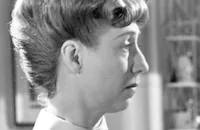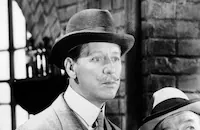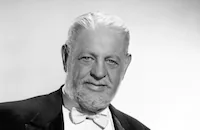Remember the Day

Brief Synopsis
Cast & Crew
Henry King
Claudette Colbert
John Payne
John Shepperd
Ann Todd
Douglas Croft
Film Details
Technical Specs

Synopsis
On the night that presidential nominee Dewey Roberts is to speak at a banquet at the Mayflower Hotel in Washington D.C., elderly teacher Nora Trinell arrives to wish him luck, for Dewey is one of her former pupils. As she listens to the band playing Dewey's favorite song, "(Back Home Again in) Indiana," Nora reminisces about when they met in Indiana on 14 Apr 1916: Nora is a new teacher taking over Dewey's class, and she dismays the headstrong young boy by announcing that she will be taking the class to a play matinee on the same day that he is to pitch in an important baseball game. Dewey appeals to his coach and manual training instructor, Dan Hopkins, who in turn asks Nora to postpone the matinee. Although Nora does not appear to be swayed, she and Dewey do find a common interest in boats and resolve to become friends. Nora does let Dewey play in the game, which she attends with Kate Hill, another of her pupils, who likes Dewey. Dewey's knee is injured in the game, but Nora visits him at home to continue his education. Nora gently guides the boy into becoming more studious and living up to his potential, and he soon develops a worshipful crush on her. Meanwhile, Dan also becomes enamored of Nora and pursues her. At the semester's end, Nora goes with the other women teachers on a summer holiday, but is soon bored and is very happy when Dan turns up one afternoon. Nora spends the rest of the summer at Avery Farm with Dan, and the two fall deeply in love. When school resumes in the fall, Nora and Dan decide to keep their relationship a secret and marry at Christmas. Dewey, who has refused to go away to prep school so that he may remain near Nora and play football for Dan, builds a sailboat modeled after one in the picture postcards of Avery Lake that both Dan and Nora sent him. Mr. Steele, the school's principal, sees the postcards and assumes that Dan and Nora spent the summer together having an illicit love affair. Wishing to spare Nora's reputation, Dan agrees to resign but asks Steele not to tell Nora why. After Dan tells Nora that he resigned in order to get a better job, he goes to Chicago, and autumn quickly passes. At Christmas, Dan returns in uniform and tells Nora that he has joined the Royal Canadian Engineers. Because Dan must go overseas in two weeks, Nora decides that she wishes to marry him immediately, and the couple spend an idyllic honeymoon at Avery Farm. After welcoming in 1917 together, Dan and Nora return to the school, where Dewey, after seeing them kissing, feels that they have betrayed him. Heartbroken that Nora could love someone else, Dewey decides to go to boarding school and is about to leave without saying goodbye to Nora when she comes to his house. Nora explains to the boy that although he is very special to her, she loves Dan. Inspired by her words of encouragement, Dewey happily boards the train, which also carries Dan, and the pair wave goodbye to Nora as they leave the station. After her reminiscences, Nora finds another of her former pupils, Bill Tower, who is now a bellboy at the hotel. Bill sneaks Nora into Dewey's office, but Dewey does not recognize her as she tells him how proud she is of him. In the elevator, however, Dewey remembers Nora and sends a hotel detective to find her. Dewey and Kate, who are now married, warmly welcome Nora, and Dewey tells Kate that all those years ago, on the train, Dan told him that he and Nora were married. Nora quietly informs them that Dan was killed in France, then attends the banquet with Kate. As the applause for Dewey swells, Nora proudly tells Kate that he was always a good boy.

Director
Henry King
Cast

Claudette Colbert

John Payne

John Shepperd

Ann Todd
Douglas Croft

Anne Revere

Frieda Inescourt
Harry Hayden
Francis Pierlot

Marie Blake
William Henderson
Chick Chandler
Selmar Jackson
William Halligan
George Ernest
Harry Tyler
Jody Gilbert

Irving Bacon

Paul Harvey

Thurston Hall
Billy Dawson
George Chandler
Geraldine Hall
John Hiestand
Kay Linaker
William E. Byrne
Darwood Kaye
Truman Van Dyke
Maxine Tucker
Lillian West
Cecil Weston
Vera Lewis

Mae Marsh
Paul Stanton

William Davidson
Ed Dearing
Harry Harvey Jr.
David Holt
Virginia Brissac

Byron Foulger
Paddy O'flynn
John Bohn
George Dobbs
Lester Dorr
Arthur Rankin
George O'hara
Frank Melton
Ruth Robinson
Paul Mcvey
James Blaine
Allen Wood
Steve O'brien
Mel Ruick
Florence Wright
Roseanne Murray
Harry Carter
Charles Tannen
Crew
Joseph E. Aiken
George Barnes
Harry Brand
Frank Davis
Richard Day
James F. Hanley
Roger Heman
Wiard B. Ihnen
William Koenig
Thomas Little
Barbara Mclean
Alfred Newman
Guy Pearce
William Perlberg
Allan Scott
Tess Slesinger
Gwen Wakeling
Henry Weinberger
Darryl F. Zanuck

Film Details
Technical Specs

Articles
Remember the Day
However it happened, Colbert gave a touching and vanity-free performance under the practiced eye of director Henry King, who was skilled at evoking small-town America. Colbert was famously fussy about how she was lit and shot -- a cameraman on an earlier film, noting the star's insistence on allowing only the left side of her face to be photographed, referred to her right profile as "the dark side of the moon." However, King (and others) have said that her no-right-profile dictate was her only demand, and for the scenes in which she played Nora as an older woman, King said she had no problem being made up to look like one. In an interview with Colbert biographer Lawrence J. Quirk, King also mentioned her kindness to less experienced players, particularly Douglas Croft, who played the boy she befriends. "She got him to glow with confidence," King recalled, "and I saw her do the same thing with her romantic lead, John Payne, who was then a Fox stock player more noted for his good looks than for his acting skills. Payne gave one of his best performances in that picture."
Actor John Shepperd -- who played the grown-up Dewey, and later used his real name, Shepperd Strudwick, professionally -- also noted Colbert's talent and lack of vanity: "Claudette never got credit for her character portrayals. If she had chosen she could have done middle-aged roles most profitably."
According to Colbert biographer Bernard F. Dick, 20th Century Fox studio head Darryl F. Zanuck intended Remember the Day to be more overtly political. In 1940, President Franklin D. Roosevelt ran for re-election on a platform of staying out of the war which had engulfed Europe. His Republican opponent Wendell Willkie, a liberal businessman who had never held elective office, advocated supporting the Allies in the war. Zanuck envisioned the film's Willkie-like character changing his previously isolationist views and embracing support for the Allies after re-encountering his former teacher, but given the fraught politics of the era and the threat of war, that angle was considered too controversial. Remember the Day opened just two weeks after Pearl Harbor, and if Zanuck's idea had prevailed, it might have given the film a stronger ending. As it was, critics compared Remember the Day to Goodbye Mr. Chips and were kind, if not particularly excited about it.
Back at Paramount, Colbert returned to familiar territory with her next film, The Palm Beach Story, a sublime Preston Sturges screwball comedy. She was 38 but looked younger, played younger, and continued doing what she excelled at, comedy. Sweetness and nostalgia were fine, and Colbert had proved that she could handle a character role, but she wasn't ready to make that transition just yet. In the years that followed, she aged slowly, gracefully, and beautifully, and never really abandoned her glamorous leading lady status.
Director: Henry King
Producer: William Perlberg
Screenplay: Tess Slesinger, Frank Davis, Allan Scott
Cinematography: George Barnes
Editor: Barbara McLean
Costume Design: Gwen Wakeling
Art Direction: Richard Day, Ward B. Ihnen
Music:Alfred Newman
Principal Cast: Claudette Colbert (Nora Trinell), John Payne (Dan Hopkins), John Shepperd (Dewey Roberts), Ann Todd (Kate Hill), Douglas Croft (Dewey Roberts as a boy), Jane Seymour (Mrs. Roberts), Anne Revere (Miss Price), Frieda Inescourt (Mrs. Dewey Roberts), Harry Hayden (Mr. Roberts), Francis Pierlot (Mr. Steele), Marie Blake (Miss Cartwright)<
85 minutes
by Margarita Landazuri

Remember the Day
Quotes
Trivia
Notes
According to information in the Twentieth Century Fox Records of the Legal Department and the Produced Scripts Collection at the UCLA Arts Library-Special Collections, the character of "Dewey Roberts" was loosely based on Wendell Willkie, who ran for president on the Republican ticket in 1940. A memo in the legal records notes that executive producer Darryl F. Zanuck had discussed the characterization with Willkie, and that Willkie approved of the dramatization of similarities between himself and "Dewey Roberts." The legal records also report that the sequences by the lake were shot at Malibu Lake, CA. According to a Hollywood Reporter news item, Harry Hayden replaced Grant Mitchell in the role of "Mr. Roberts" because Mitchell was committed to Warner Bros.' The Man Who Came to Dinner. Hollywood Reporter also noted that Jack Grimes, a fourteen year-old radio actor, was to be included in the cast, but his participation in the completed picture has not been confirmed. Jane Seymour, who played "Mrs. Roberts" in the film, played the same role during the play's Broadway run (25 September 1935). According to the Hollywood Reporter review, the film was tradeshown to the press in Glendale on December 18, 1941, the same night as "America's first war blackout." The picture was remade as a television presentation for the 20th-Fox Hour. Entitled Men in Her Life, it starred Phyllis Kirk and Kendall Scott, was directed by Lewis Allen and aired in April 1957.














